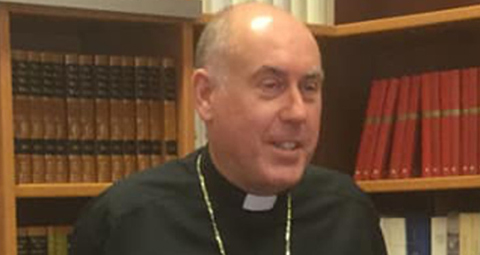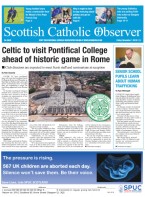BY Peter Diamond | November 23 | ![]() 0 COMMENTS
0 COMMENTS ![]() print
print

Argyll and the Isles looks to Faithful to combat ‘perilous’ budget deficit
The Bishop of Argyll and the Isles has said he is confident that the diocese’s deficit of nearly £90,000 can be wiped by support from parishes.
Bishop Brian McGee addressed the ‘dire’ state of his diocese’s finances with three publications, which aim to give ‘full transparency’ about the weekly offertory collection.
A leaflet, a letter and a document have outlined the details of the deficit.
Bishop McGee (right) spoke of a ‘perilous situation’ with budget figures for 2019 stating that it will cost £296,118 to run the diocese.
“Our highest costs are diocesan administration; Sick and Retired Priests fund (we presently have seven), Student Priests Fund (we presently have two) and CNET (Bishops’ Conference) which pays for national commitments such as the [Interdiocesan] Tribunal, Scottish Catholic Education Service, Parliamentary and Press Offices etc.
“We have more churches per head of population than any other diocese, which are often battered by the inclement weather and our priests have more ground to cover.”
2019 projection
The expected income of Argyll and the Isles diocese is £207,883 and expenditure for the coming year is set at £296,118, meaning a deficit for 2019 projected to be £88,235.
From December 1 the diocese levy for each parish will increase, with the bishop asking each parishioner to donate an extra £1 per week to the offertory collection, if they can.
The diocese believes the measure will increase parish income and eradicate the diocesan deficit.
Bishop McGee added: “We felt it was essential that our parishioners were made aware of the financial situation we find ourselves in—it’s their money that goes into the collection each week and these documents will clearly outline where the money is spent.”
Needs
According to the figures, Argyll and the Isles Diocese, which has existed since 1878, will run out of money and assets in nine years if the deficit is not reduced.
The diocese needs an extra £88,000 per annum to break even.
Bishop McGee added: “We are not looking to make a profit—we are looking to break even. If everyone puts in an extra £1 then 61 pence will go to the diocese and 39 pence will stay with each parish.
“However, since an average of 2,793 people attend Mass every Sunday, a £1 increase over and above what they already donate, would cover this.
“The diocesan trustees, diocesan finance board and the diocesan staff have been working hard to resolve this problem. Over the past six months there has been extensive consultation with the clergy and parish finance committees.
“Our priests in the diocese have also been very supportive of what information we are making public and they are hearing positive feedback from the lay people, so things are very hopeful.
“Communication has been key to getting the message out there and we will continue to refresh the information our parishes receive with quarterly updates about the state of the finances in a report published on the website.
“In the Church we can be not great at explaining situations and we thought it would be more beneficial to give our congregations full transparency of the situation.
“Most people will be unaware of where their money goes when they hand over the weekly collection but these documents clearly outline diocese spending towards God’s work, which we believe is a good thing.”
Campaign
Bishop McGee, who was appointed to Argyll and the Isles Diocese in 2016, says his experience as vicar general when he served in Paisley Diocese convinced him to tackle the finances in his new position.
In January 2017 Paisley Diocese launched an innovative new campaign to try and pay off its £3 million deficit.
It encouraged parishioners to become ‘friends’ of various diocesan projects and donate money to help clear an annual shortfall of £300,000.
Bishop McGee added: “I was here when the campaign began in Paisley but I was made aware of their deficit when I was serving in the diocese as vicar general.
“That experience convinced me to tackle the issue of finance when I was appointed to this diocese.
“Each diocese approaches things differently. For us we are the smallest in terms of population but we are the furthest spread.
“We are unique in that we have a lot of churches that are battered by the weather and we have big distances between parishes.
“A priest may need to travel 70 or 80 miles to attend to a sick person in our diocese and there is an added burden of travel cost or things like petrol or taking the boat in order to say Mass or attend meetings.”
Bishop’s House
The diocese considered selling Bishop’s House in Oban, however, because it is the only building which the diocese owns and is still used as an office and for meetings, the option was not thought viable.
Bishop McGee added: “The house in Oban was mentioned because we have to think of all possibilities, however it would only plug the funding gap for a year or two and it still has a number of functions.
“It is used by the diocese administration as an office—rent free—and for clergy meetings, so we have investigated the possibility of selling it, but we’d rather not.”
Bishop McGee, who has been working in parishes in Caol for a number of weeks covering for sick priests, will return to regular appointments next week.










